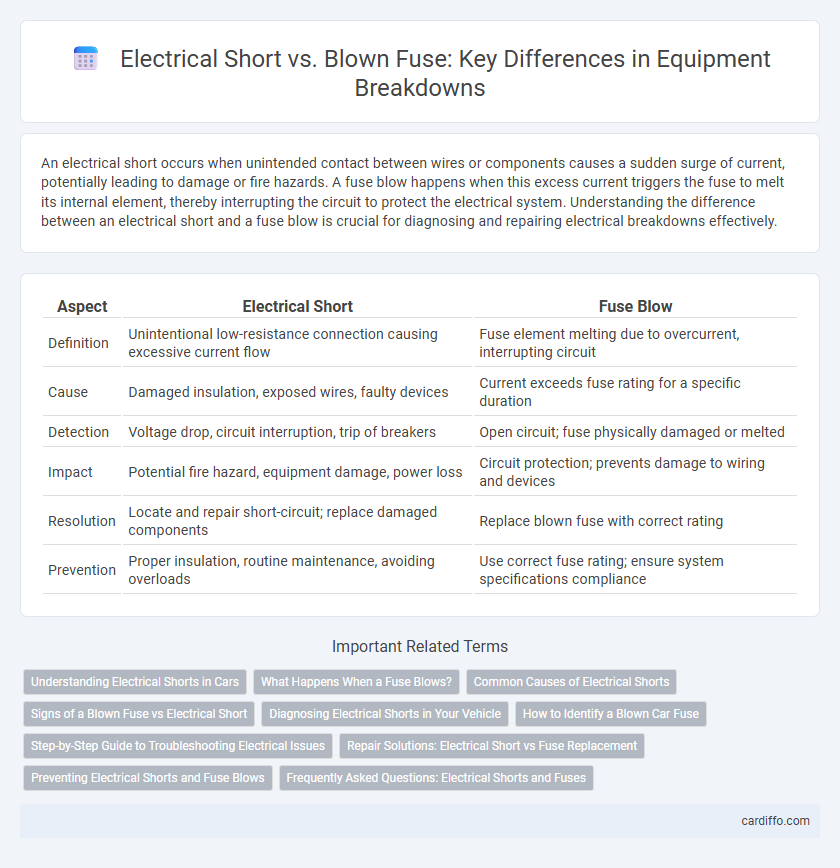An electrical short occurs when unintended contact between wires or components causes a sudden surge of current, potentially leading to damage or fire hazards. A fuse blow happens when this excess current triggers the fuse to melt its internal element, thereby interrupting the circuit to protect the electrical system. Understanding the difference between an electrical short and a fuse blow is crucial for diagnosing and repairing electrical breakdowns effectively.
Table of Comparison
| Aspect | Electrical Short | Fuse Blow |
|---|---|---|
| Definition | Unintentional low-resistance connection causing excessive current flow | Fuse element melting due to overcurrent, interrupting circuit |
| Cause | Damaged insulation, exposed wires, faulty devices | Current exceeds fuse rating for a specific duration |
| Detection | Voltage drop, circuit interruption, trip of breakers | Open circuit; fuse physically damaged or melted |
| Impact | Potential fire hazard, equipment damage, power loss | Circuit protection; prevents damage to wiring and devices |
| Resolution | Locate and repair short-circuit; replace damaged components | Replace blown fuse with correct rating |
| Prevention | Proper insulation, routine maintenance, avoiding overloads | Use correct fuse rating; ensure system specifications compliance |
Understanding Electrical Shorts in Cars
Electrical shorts in cars occur when unintended contact between conductive parts causes a surge of current, often leading to malfunction or damage. This sudden spike can blow fuses, which act as protective devices designed to interrupt the circuit and prevent further harm. Identifying and repairing the exact location of the short circuit is essential to restore proper electrical function and avoid repeated fuse blowouts.
What Happens When a Fuse Blows?
When a fuse blows, it disrupts the electrical circuit by melting its internal wire or element due to excessive current flow, effectively stopping the electrical current to prevent damage. This interruption protects appliances and wiring from overheating, fires, or further electrical faults. Understanding fuse operation helps in diagnosing issues by indicating that the circuit experienced an abnormal surge or short circuit, triggering the fuse to blow.
Common Causes of Electrical Shorts
Electrical shorts commonly occur due to damaged or frayed wiring insulation, which allows unintended contact between conductors. Corroded connections and loose terminals increase resistance and generate heat, often leading to short circuits. Faulty appliances and overloaded circuits also contribute significantly to electrical shorts, triggering protective measures like fuse blowing.
Signs of a Blown Fuse vs Electrical Short
A blown fuse typically causes a complete loss of power in a specific circuit, often resulting in no response from connected devices or fixtures. In contrast, an electrical short usually produces visible sparks, a burning smell, or flickering lights, indicating a sudden surge or fault in the wiring. Identifying the signs, such as a popped fuse versus burning odors or electrical arcing, helps diagnose whether the issue is a fuse failure or a short circuit.
Diagnosing Electrical Shorts in Your Vehicle
Diagnosing electrical shorts in your vehicle requires careful inspection of wiring harnesses, connectors, and fuse boxes for signs of melted insulation or burnt marks. Use a multimeter to check for continuity and identify where current is flowing abnormally, indicating a short circuit. Replacing blown fuses with the correct amperage rating prevents further damage while pinpointing the source of the fault.
How to Identify a Blown Car Fuse
To identify a blown car fuse, begin by locating the fuse box, typically found under the dashboard or in the engine compartment, and visually inspect each fuse for a broken metal filament or discoloration. Use a multimeter set to continuity mode to test fuses; a blown fuse will show no continuity, confirming an electrical short or overload has occurred. Replacing the blown fuse with one matching the vehicle's specified amperage rating ensures proper circuit protection and prevents further electrical breakdowns.
Step-by-Step Guide to Troubleshooting Electrical Issues
Identify an electrical short by inspecting wiring for exposed conductors or melted insulation causing current to bypass normal paths, which often leads to circuit breakers tripping or fuse blowouts. Test fuses with a multimeter to determine continuity; a blown fuse will show no continuity, indicating it acted as a protective device against overcurrent. Follow a systematic process by isolating circuit sections, checking for proper voltage levels, and replacing faulty components to restore safe electrical functionality.
Repair Solutions: Electrical Short vs Fuse Replacement
Repair solutions for electrical shorts often involve pinpointing the exact location of the short circuit and repairing damaged wiring or components to restore proper function. Fuse replacement is necessary when a fuse blows due to overcurrent, serving as a protective measure, but simply replacing the fuse without addressing the underlying cause of the short may lead to repeated failures. Technicians prioritize diagnosing the root cause of the fault to ensure comprehensive repairs, combining circuit testing, insulation checks, and component evaluation to prevent future breakdowns.
Preventing Electrical Shorts and Fuse Blows
Electrical shorts occur when unintended contact between live conductors creates a low-resistance path, causing excessive current flow that can blow fuses and damage circuits. Preventing electrical shorts involves using proper insulation, secure wiring connections, and regular maintenance to identify worn or damaged components. Selecting the correct fuse rating ensures circuit protection without nuisance blows, maintaining system safety and reliability.
Frequently Asked Questions: Electrical Shorts and Fuses
An electrical short occurs when a low-resistance connection allows an excessive current flow, often causing circuit damage or fire hazards. A fuse blow happens when the fuse element melts due to overcurrent, protecting the circuit by interrupting power. Common questions include how to identify a short circuit, troubleshoot fuse failures, and prevent repeated fuse blows.
Electrical short vs fuse blow Infographic

 cardiffo.com
cardiffo.com